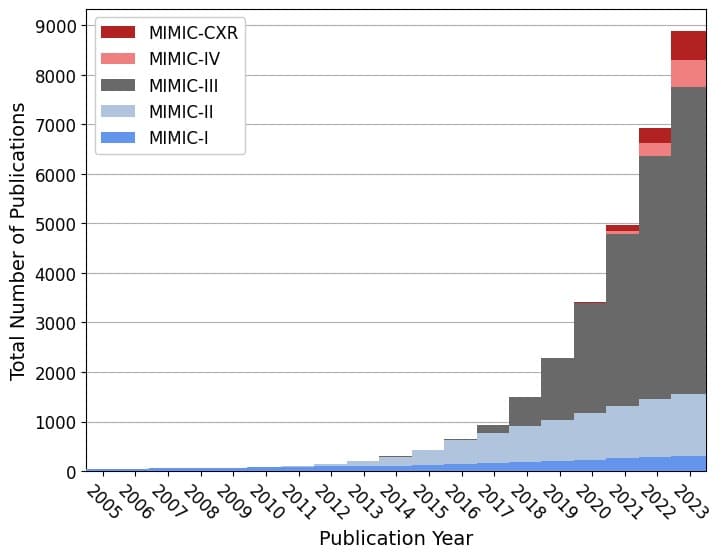An ecosystem that improves healthcare with data science and community bridging
MIT Critical Data develops local AI capacity in healthcare by building open data & software, fostering community engagement through datathons, and advocating for AI equity in research.
- Research
We strongly believe in AI health equity. We lead the research community in how to achieve this goal.
- Events
We believe in developing data communities and local AI capacity. We host datathons globally to achieve this.
- Resources
We develop and share open source health data, software, and resources to foster healthcare innovation.
Our Mission
Our mission is to unite clinicians, data scientists, engineers, and research communities around the world to revolutionize healthcare in a way that is democratised, decentralised, and equitable. We achieve this by publishing open health data and software tools; training local communities to build AI capacity through datathons; and advocating for diversity and equity in AI.
We work with and develop multidisciplinary teams from around the world to build local capacity.
Our Impact
A key part of our mission is to build global capacity in Health AI and data science.
Datasets
260+
Open health datasets have been shared through our PhysioNet platform.
This has led to more than 2000 new publications in the last 4 years.
MIMIC Footprint
10k+ citations
The MIMIC dataset has been cited more than 10,000 times in scientific publications.

AI Capacity Building
100+ events
We have trained 5000+ people in data science and AI through our events and workshops.
Hosted in 39 countries, training a generation of AI-ready clinicians, researchers, and engineers.
Community
80k+ people
People have used our datasets, leading to a phenomenal scientific footprint.
The MIMIC dataset alone has been cited more than 10,000 times in scientific publications.
- 2016-01-01Springer OpenSecondary Analysis of Electronic Health RecordsCharlton P, Ghassemi M, Johnson AE, Komorowski M, Marshall D, Neumann T, Paik K,...+ More
- 2016-05-24Nature Scientific DataMIMIC-III, a freely accessible critical care database.Johnson AEW, Pollard TJ, Shen L, Lehman L, Feng M, Ghassemi M, Moody B, Szolovit...+ More
- 2022-07-11JAMA Internal MedicineAssessment of Racial and Ethnic Differences in Oxygen Supplementation Among Patients in the Intensive Care UnitGottlieb ER, Ziegler J, Morley K, Rush B, Celi LA
- 2021-07-03JAMA Network OpenDiscrepancies Between Pulse Oximetry and Arterial Oxygen Saturation Measurements by Race and Ethnicity and Association With Organ Dysfunction and Mortality.Wong AI, Charpignon M, Kim H, Josef C, de Hond AAH, Fojas JJ, Tabaie A, Liu X, M...+ More
- 2018-10-22Nature MedicineThe Artificial Intelligence Clinician learns optimal treatment strategies for sepsis in intensive careKomorowski M, Celi LA, Badawi O, Gordon AC, Faisal AA.
- 2022-05-11The Lancet Digital HealthAI recognition of patient race in medical imaging: a modelling studyGichoya JW, Banerjee I, Bhimireddy AR, Burns JL, Celi LA, Chen LC, Correa R, Dul...+ More
- 2022-07-05Springer Journal of Digital ImagingDeveloping and Validating Multi-Modal Models for Mortality Prediction in COVID-19 Patients: a Multi-center Retrospective StudyWu JT*, de la Hoz MÁA*, Kuo PC*, Paguio JA, Yao JS, Dee EC, Yeung W, Jurado J, M...+ More
- 2023-08-14PLOS Global Public HealthA new tool for evaluating health equity in academic journals; the Diversity Factor.Gallifant J, Zhang J, Whebell S, Quion J, Escobar B, Gichoya J, Herrera K, Jina ...+ More
- 2020-09-01The Lancet Digital HealthThe myth of generalisability in clinical research and machine learning in health care.Futoma J, Simons M, Panch T, Doshi-Velez F, Celi LA.
2Community Building
We host events globally to build Health AI capacity in local communities
Every month we move around the world to train the global community on how to leverage open data, develop AI models, and evaluate AI tools in healthcare. Advancing safe, equitable, and democratised Health AI can only be reliably achieved together with collective expertise. We build that global AI capacity through datathons and health & systems thinking for equity workshops hosted worldwide.



